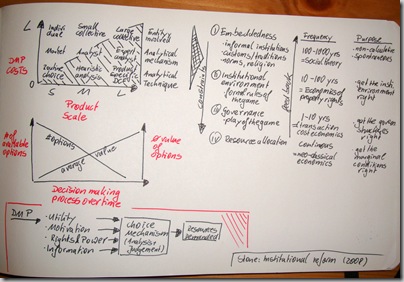Stone, Alastair: Institutional reform – A decision-making process view; in: Research in Transportation Economics, Vol. 22 (2008), No. 1, pp. 164-178.
Stone analyses the fundamentals of the DMP (decision-making process) and proposes a model which he then applied to the example of urban land passenger transport. This summary focuses on the analysis of the DMP. Firstly, Stone draws a model which combines DMP costs with product scale and assumes a positive correlation between these two = the larger the product the higher the DMP costs. He outlines the entity involved, analytical mechanisms, and analytical techniques, e.g., for large-scale products the entity is usually a large collective, an expert analyst is the mechanism of choice for analysis, and a product specific discounted cash flow is the technique for the analysis. Secondly, Stone shows that over time in the DMP the number of options decreases, whilst the average value of each option increases.
More interestingly he looks at different decisions and identifies 4 levels of societal decision processes
- Embeddedness = informal institutions, customs and traditions, norms and religion (happens every 100 to 1.000 years; is explained by social theory; and the purpose of it is non-calculative and spontaneous)
- Institutional environment = formal rules of the game (happens every 10 to 100 years; is explained by economics of property rights; and the purpose of it is to get the institutional environment right)
- Governance = play of the game (happens every 1 to 10 years; is explained by transaction cost economics; and the purpose of it is to get the governance structures right)
- Resource allocations (happen continuously; is explained by neo-classical economics; and have the purpose of getting the marginal conditions right)
Higher level impose constraints on lower level decisions, whilst these return feedback to the top. Finally, he outlines the DMP:
Input Variables (utilities, motivation, rights & power, and information) go into the Choice Mechanism (analysis & judgement) and result in a Resource Demand.

